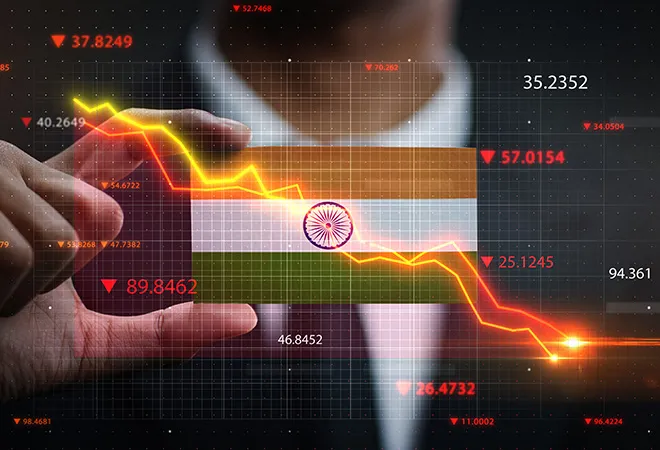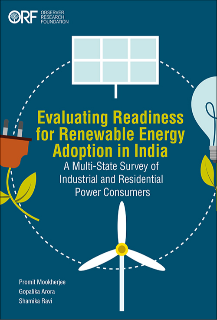
The contraction in India’s gross domestic product (GDP) was predicted. A big fall, in tune with the rest of the world’s economies, was expected. But that almost a quarter of the GDP would be shaved off in the first quarter of financial year 2021 is a shock. The exodus of migrant labour had brought us the images months ago. The data released on 31 August 2020 is a confirmation of those images and give a numerical precision of the economic woes —
India’s GDP has contracted by 23.9% between April and June 2020. In other words, Coronavirus and the resultant lockdowns has eaten Rs 8.45 lakh crore worth of economic activity in the first three months of the financial year.
Nothing illustrates this fall better than the railways. While passenger kilometres came to a standstill, falling 99.5% in the three months (matching the fall of 94% in airline passengers), net tonne kilometres or the amount of goods carted by the railways fell by 26.7%. With no hands to man the machines, manufacturing contracted by 40.7%, steel consumption fell by 56.8%, cement by 38.3%. In terms of gross value added, construction contracted by 50.3%, while hotels, transport and communications fell by 47%.
This is an economic devastation. In themselves, the numbers are bad enough. But behind every statistic above are millions of people below. With jobs gone, and in the foreseeable future no sign of them returning, there is economic agony ahead. The lockdowns may have saved lives in the short term. But in the medium to long term, they have destroyed the economy. Unless the economy becomes the government’s first and foremost task, through actions and not rhetoric, India will not recover. The
Rs 20 lakh crore package the Union government announced in mid-May seems woefully inadequate.
On intent, the government has no shortages. On slogans, it has a surplus. But on execution, its hands are tied by two iron chains. First, a per capita income of $2,100. This gives it no room for economic manoeuvring, unlike say the UK or Germany that sit on per capita incomes of $42,300 and $46,259 and can deliver economic sustenance to citizens. Second, a broken healthcare system, the results of which are visible today. Crises are opportunities for investments in policy choices, they cannot create hospitals overnight. At best, these can be triggers for greater investment and catalyst for policies that invite private capital into the sector.
With this fall, the Indian economy not only joins but leads the global contraction underway (See table). Among all trillion-dollar economies, only one — China — has shown a rise in GDP. Every other country, from the UK and the US to Japan and South Korea, has contracted. The biggest fall, after India’s, has been in the UK (a quarter on quarter contraction of 20.4% and a year on year fall of 21.7%). As a trend, the West has fallen more than the East, with five countries — the UK, France, Italy, Canada and Germany — contracting by double digits over their 2019 quarter. In the East, only India and Japan (a fall of 10%), are in the double-digit category. This fall will impact annual IMF projections from the current 4.5% contraction.
|
GDP growth for the quarter ended June 2020 (in %)
|
|
| Country |
Change over previous quarter |
Change over same quarter of previous year |
IMF projections for 2020 |
| India |
-29.3 |
-23.9 |
-4.5 |
| United Kingdom |
-20.4 |
-21.7 |
-10.2 |
| France |
-13.8 |
-19.0 |
-12.5 |
| Italy |
-12.4 |
-17.3 |
-12.8 |
| Canada |
-12.0 |
-13.5 |
-8.4 |
| Germany |
-9.7 |
-11.7 |
-7.8 |
| Japan |
-7.8 |
-10.0 |
-5.8 |
| United States |
-9.5 |
-9.5 |
-8.0 |
| South Korea |
-3.3 |
-2.9 |
-6.6 |
| China |
11.5 |
3.2 |
1.0 |
| Euro area |
-12.1 |
-15.0 |
-10.2 |
Data: India (
Ministry of Statistics and Programme Implementation); Others: (
OECD)
If even after this economic calamity, the governments (Union and states) do not clear the hurdles that stand before doing business, India’s last decade from which a demographic dividend can be extracted will be over. Quarter to quarter, a decade looks long enough to let linger the economic status quo. But it will end faster than we can imagine. And before we know it, the opportunity would have passed India by.
Going forward, on the economic side there is only one policy India needs to follow: increases the per capita income to $10,000 by 2030. The time for incremental growth is over. India needs to draft policies that have to potential to deliver exponential growth. That growth needs capital, financial savings, and a larger number of Indians paying taxes. It also means that the incremental capital output ratio — the additional unit of capital needed to produce an additional unit of output — that has been
ranging between 3.5 and 4.5 for the past three decades, needs to fall and deliver a higher productivity of capital.
While technology will do its bit to strengthen this ratio, policy will have to play an enabling role. The one advantage India has is the ability to produce public goods around technology, of which the JAM (the linkage of Jandhan account, Aadhaar, and mobile phone) trinity is one, the
Pradhan Mantri Jan Arogya Yojana another. Coming up are several other innovations around finance and healthcare. These need to be leveraged, and expanded to serve the biggest value creators of India — the entrepreneurs. The entire compliance network, for instance, needs to be digitised and become faceless.
If the worst contraction in recent history, the biggest reduction in GDP among peers, the largest potential fallout in terms of unemployment cannot trigger a change that leans towards entrepreneurs, nothing ever will. The crisis of contraction will turn out to be only the tip of the iceberg if immediate and far-reaching policy changes that encourage entrepreneurs to take risks and create jobs are not delivered. This continued obsession with wealth redistribution and the underlying timidity if not outright aversion to wealth creation will be the greatest undoing of India. It’s time to give India’s wealth creators a chance.
The views expressed above belong to the author(s). ORF research and analyses now available on Telegram! Click here to access our curated content — blogs, longforms and interviews.



 The contraction in India’s gross domestic product (GDP) was predicted. A big fall, in tune with the rest of the world’s economies, was expected. But that almost a quarter of the GDP would be shaved off in the first quarter of financial year 2021 is a shock. The exodus of migrant labour had brought us the images months ago. The data released on 31 August 2020 is a confirmation of those images and give a numerical precision of the economic woes —
The contraction in India’s gross domestic product (GDP) was predicted. A big fall, in tune with the rest of the world’s economies, was expected. But that almost a quarter of the GDP would be shaved off in the first quarter of financial year 2021 is a shock. The exodus of migrant labour had brought us the images months ago. The data released on 31 August 2020 is a confirmation of those images and give a numerical precision of the economic woes —  PREV
PREV


